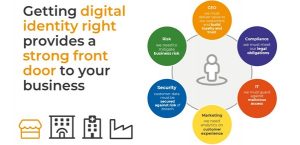What is digital identity?
Digital identity, a digitised version of our identity, whether it is a digital version of our passports, ID cards, licenses, staff login credentials tied to our employee records in the staff database, or customers who form part of a company’s customer base. It is ever present and essential to each individual and organisation across the world.
From an organisation’s standpoint, digital identity is often easily understood when split into two main components – internal identities and external identities. Internal identity refers to staff, whilst external identity refers to the likes of suppliers, partners, and customers.
What is Identity and Access Management?
Identity and access management (IAM) is a framework combining business processes, policies, and technologies. These combining factors simplify how organisations manage digital identities. An IAM framework allows:
is a framework combining business processes, policies, and technologies. These combining factors simplify how organisations manage digital identities. An IAM framework allows:
- IT managers to control user access
- Organisations to require single sign-on, two-factor authentication, multifactor authentication for user access
- Organisations to meet data governance and compliance standards by securing data and storing or saving as required
An IAM system is made up of a few fundamental components, such as:
- how individuals are identified in a system.
- how roles are identified and assigned to groups or individuals, including their levels of access.
- how accounts are managed, for example, by adding, removing, and updating individuals and their roles in a system.
- how sensitive data is protected and secured.
IAM is essential to an organisation’s security, protecting against weak passwords and hacked credentials, or any other common entry point for hackers seeking to cause trouble and steal data.
Why is Identity and Access Management important?
Organisations are constantly under increasing pressure to protect systems and the users within them. This comes as no shock as data breaches are very much a real thing. Good IAM not only makes resources more secure, but also simplifies and automates control and the effectiveness of company processes.
Keeping today’s digital world in mind, IAM offers a variety of advanced features ranging from behaviour analytics and biometrics, to AI technologies. Finding the balance between good user experience and a secure system is fundamental to the development of identity and access management.
Good IAM ensures businesses enhance their productivity and workflow through and seamless functioning systems. Employees can work with ease, no matter where they are, as centralized management makes sure they only access resources relevant to their job and the task at hand. All in all, this system functionality means for efficiency at reduced costs for the likes of contractors, customers, and suppliers.
What does good Identity and Access Management look like?

IAM is a fundamental need for all organisations operating in a digital world. Good Identity and Access Management gives organisations a platform to engage with their customers, employees and partners in a trusted and secure way that is scalable to meet future digital demands. Identity is evolving faster than ever, stay tuned for more as we take good identity into 2022 and discuss the latest identity and access management trends for 2022 and beyond.